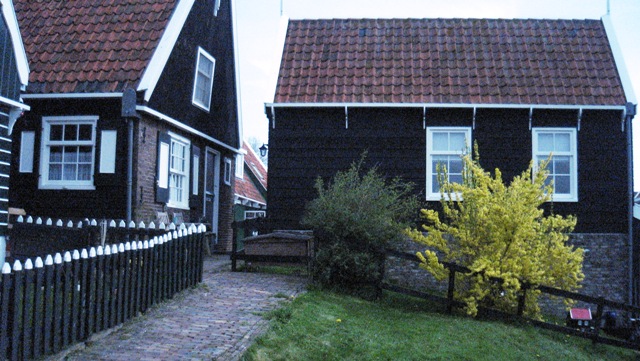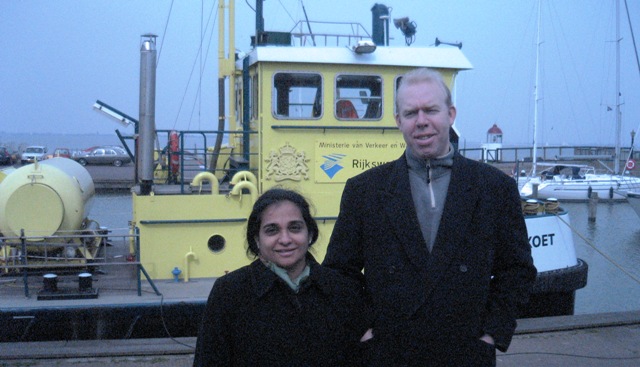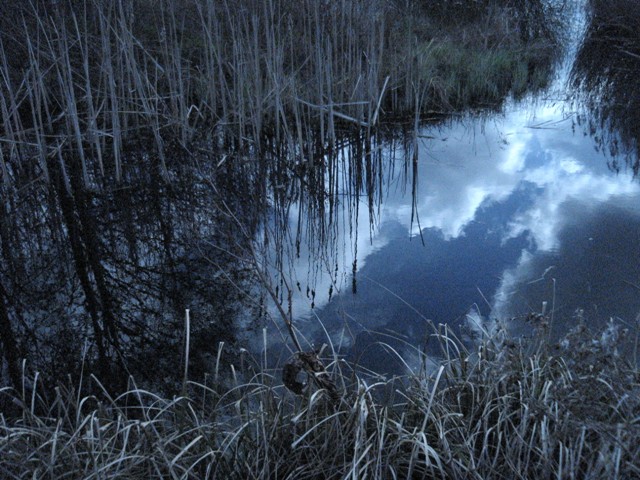Thursday, April 27, 2006
JANE JACOBS – ALMA MATER
One of the dangers of reading obituaries first thing in the day is that you find out early on that people you value highly have left the stage – and there’s a risk that that can sour the rest of the day. Sometimes, though, it’s a matter both of regret and celebration, and that is certainly true of today’s announcements (The Times, Financial Times) that Jane Jacobs has died, aged 89. Very, very few people have had such a profound impact on my thinking, even though I suspect she isn’t covered in my ‘Influences’ section on this website. Partly that’s because such influences only become clear in hindsight.
Can only agree with the FT’s obituarists, Martin Wolf and Jeff Pruzan, that Jacobs was “a genius – no other word will do.” Her book The Death and Life of Great American Cities still sits on our bookshelves, dating back to 1961, though I only got around to reading it in 1972. At the time I was starting an M. Phil. at the School of Environmental Studies, University College London. Whatever the UCL folk intended, the initial impact of their teaching was one of “here’s the planning system – and here’s how you will operate it.” Jacobs, by contrast, launched her own counter-revolution to top-down planning, building on her personal experience of New York, particularly Greenwich Village.
In retrospect, it was no accident that my eventual thesis, which came in at book-length (80,000 words instead of the 20,000 allowed), pretty much split the examiners, several of whom disputed whether the subject had anything at all to do with planning-as-then-practised. Exactly. I had looked at the lessons that could be learned from community-built-environment relationships about how to regenerate ageing urban infrastructure in places like London’s Covent Garden, Amsterdam (where I was reminded last week of the way-back plans to turn the city’s canals into roads, only turned down by a single vote), and Venice, rather than razing older communities and starting again with (not-necessarily-by-design) inhuman styles of development. More than anyone else, Jane Jacobs started that particular snowball rolling and I found myself entrained.
Truly, she was alma mater (nourishing mother) to my growing fascination with cities as organic entitities, which in turn led me to a close friendship with planner-turned-urban-entrepreneur Mike Franks of Regeneration. And, given that (as Wolf and Pruzan note) the first 80 pages of Death and Life were devoted to the crucial importance of sidewalks in defining urban quality of life, it is perhaps not surprising that my first job on leaving UCL was with John Roberts and TEST, where we spent several crucial years focusing on – among other things – ‘improving the pedestrian’s environment’ and pedestrianisation.
In terms of my long-term fascination with sustainability, it’s interesting to note her key distinction between expansion and development. The Times quotes her as follows: “They need each other. But they aren’t the same thing. I think perhaps that’s the most important thing I have worked out. And if I am thought of as a great thinker, that will be why.”
It strikes me that in my slides of the three great waves of societal pressure on business since 1960, I routinely show WWF and Amnesty being founded in 1961 and Rachel Carson coming in with Silent Spring in 1962. Jane Jacobs must be in the next edition. Indeed, my oversight is reason enough to have another go. Although I never had the privilege of meeting her, it’s a bit like losing another grandmother or godmother.
Sunday, April 23, 2006
AMSTERDAM AND ENVIRONS
We flew back earlier this afternoon from Amsterdam, where after our time with Wouter van Dieren and his IMSA colleagues we moved across the city on Friday to stay with social entrepreneur Jeroo Billimoria and her husband, Bertjan. Among other things, we had lunch in a cafe watching the myriad versions of cycles go by – I wish I had had one of the combo-cycle-wheelbarrows that now feature so prominently in the Amswterdam streetscape when Gaia and Hania were small. Next,we visited Jeroo’s canalside offices to meet colleagues from her two social enterprises, Child Helpline International (http://www.childhelplineinternational.org/index.php) and Child Savings International (http://www.childsavingsinternational.org/index.php). After dinner, the four of us took a spin around the historic core of the city.
Yesterday, Saturday, Bertjan and Jeroo drove us south to see the windmills of Kinderdijk. Then we looped back via Gouda, where some of the stained glass in St John’s Church (De Sint Janskerrk) really took my breath away, particularly the window showing the capture of Damietta. Apparently this single church now contains fully 50% of the 16th century stained glass remaining in the country. A choir was practising as we walked around, adding to the charm.
On the way to Gouda, I had brought up Admiral van Tromp (http://en.wikipedia.org/wiki/Cornelius_Van_Tromp), who I recalled affixing a broom to his mast and threatening to sweep the English from the high seas. As it turned out, he didn’t manage the trick, but (semi-miraculously) it turned out that we were just 15 minutes from his amazing house, built like a ship, sailing a moated sea. Bertjan detoured to show us. In the evening, we had dinner in a tapas restaurant on the canal in Utrecht and discussed the future.
Then, earlier today, J & B whisked us south to the IJsselmeer and out across the causeway to the former island of Marken, to see the beautiful little wooden houses of the fishing village (http://en.wikipedia.org/wiki/Marken). Next, back to Amsterdam for lunch with social entrepreneur David Rosenberg and his wife Isabel. David is the man behind Utz Kapeh (http://www.utzkapeh.org/index.php?pageID=109), a worldwide certification program that sets the standard for responsible coffee production and sourcing.
Utz Kapeh means “good coffee” in a Mayan language, with the focus here on assurance of social and environmental quality in coffee production. One area we discussed: the ways in which David and his colleagues have been working to address concerns that their approach might conflict with standards adopted by the Fairtrade movement (http://www.utzkapeh.org/index.php?pageID=145&showItem=95&filterCat=A,B,C,D). Key thing, though, for someone who has struggled somewhat to acquire a taste for fair trade coffees, is that the Utz Kapeh Ethiopian coffee is stunningly good.

I wish I had had one of these …

Elaine on Jeroo’s railway-platform-cum-sofa

One of many windmills at the Kinderdijk World Heritage site

No brooms in sight: Admiral van Tromp’s extraordinary, ship-shape home

The Capture of Damietta window, St John’s Church, Gouda

The village of Marken, in the IJsselmeer

Marken 2

Incipient Hummerization of Marken

Jeroo and Bert-Jan
Friday, April 21, 2006
MORE VAN DIEREN JUBILEE PHOTOS
Some more photos of the Wouter van Dieren Jubilee Symposium yesterday, taken by an IMSA photographer:

God knows what we’re voting on, but (third from left, front row, between Wouter and Ashok Khosla) I’m happy

Dennis Meadows, me, Wouter and Jan Marijnissen (Parliamentary and Party leader of Socialist Party)

Wouter works the audience

The gonging
Thursday, April 20, 2006
WOUTER VAN DIEREN
Yesterday, Elaine and I travelled to Amsterdam to celebrate the sixty-fifth birthday of a long-standing friend and colleague, Wouter van Dieren, founder of IMSA (hhtp://www.imsa.nl). In the evening, we went out to Ilpedam for a wonderful dinner in his home, converted from an old barn.
Then, today, I spoke at IMSA’s 20-year Jubilee Symposium at the Royal Tropical Institute in Amsterdam, entitled The Limits: Looking Back and Beyond, as part of an introductory panel session responding to an excellent presentation by Dennis Meadows, providing an update on 1972’s Limits to Growth study. The panel was chaired by Eric-Jan Tuininga and, in addition to Dennis, included Ruud Lubbers, former Dutch Prime Minister, and Jan Marijnissen, Parliamentary Chairman of the Dutch Socialist Party.
Three other plenary sessions I found particularly powerful were those spotlighting Ashok Khosla of Development Alternatives (who I visited earlier in the year in Delhi), polar explorer Robert Swan and his team member Marianne Koene, and the final session by Wouter – during which he was surprised to receive the Dutch equivalent of a knighthood from the Queen. Given that he had apparently been thrown out of the Queen’s palace a few years back, though possibly not by the Queen herself, it was fun to watch him momentarily wrestle with whether or not to accept in front of 400 people. In the end, he opted to wear the gong alongside the memory of his palatial eviction.
Elaine and I sat in on a parallel session first thing today led by Wouter’s wife, Jeannette Hoek, focusing on the work that IMSA and the OASE Foundation have been doing on biosaline agriculture (http://www.imsa.nl/uploads/OASE_work_programme.pdf). Then, later in the evening, we were invited to a dinner at an impressive restaurant overlooking the old harbour of Amsterdam.

Wouter is given a can of “meaningfullness”

As the label confirms …

Ashok Khosla and Friedrich (‘Bio’) Schmidt-Bleek

Eric-Jan Tuininga and Wouter – sporting his gong

Interviews as the event winds down

Elaine and I, courtesy of Dennis Meadows
ZOUK CLEANTECH FUND
My toe continues to dip – or be dipped – into new waters. Venture capital firm zouk ventures (http://www.zouk.com) announced today the successful first closing of Cleantech Europe, its second technology fund. Cleantech Europe will be investing in clean technology businesses in areas such as renewable energy, energy storage, emission reduction, nanotechnology, water and recycling. I am now part of zouk’s Cleantech Industry Advisory Group, alongside Cyrille du Peloux (CEO of Onyx Environmental Plc), Firoz Razoul (Chairman Emeritus of Ballard Power Systems and Steven Zwolinsky (previously CEO of GE Wind Energy and now CEO Gas Turbine Efficiency plc).
Thursday, April 13, 2006
GOOD FRIDAY
Week seemed to be mainly spent in writing columns, articles and introductions for other people’s books. On Wednesday evening, though, 12-15 of us drank fond farewells to Judy Kuszewski (off to have another in the human wave of babies that has been washing through SustainAbility in recent months – among them Monty Buckingham and Norah Lee, both of whom were in attendance) and Kavita Prakash-Mani (off on a six-month sabbatical, which will take her around the world).

Rita (Khanna) and Meghan (Chapple-Brown), taken by Tell Muenzing

Frances, with invisible Monty, and Tell
Yesterday, I went across to Oxford, by train, to see Sophia (Tickell). A wonderfully stimulating conversation. We’re starting work on a position paper for our Skoll Foundation program. Met up with Geoff (Lye) afterwards. Then extraordinarily wet rain this morning as Elaine and I went back and forth to Waitrose, then Mark Lee (SustainAbility’s new CEO) and his wife Valerie, plus their daughter Norah and Meghan Chapple-Brown, who is a member of our US team, arrived for lunch.
By early afternoon, the skies were largely blue and we took a walk to the Barnes Wetlands Centre, where the kingcups are in glorious bloom – reminding me of childhood swamp delights in Northern Ireland. And Ireland also brought to mind earlier in the day when I read The Economist’s review of a new collection of poems from Seamus Heaney, District and Circle. This, apparently, is full of images of farm machinery. Given my memories of things like the itinerant steam thresher from 1950s Northern Ireland, images like that of the turnip-snedder (sic) “standing guard/on four braced greaves” conjure up extraordinary images, tastes and smells, not least of digging up turnips in the fields and eating them raw with the aid of a rusty old pen-knife.
Then, this evening, I watched a fascinating BBC program of Salah el-Din’s destruction of an evolving Crusader castle at Jacob’s Ford, a reverse which – the program makers argued – eventually led to the fall of Jerusalem and – in the wake of the much worse defeat at the Horns of Hattin – to the loss of the Crusader hold on the Holy Land. The shots of Krak des Chevaliers in Syria made me want to head back there at least once more before I shuffle off this mortal coil.

Kingcups

Birch trunks

Reflections

Reeds

Meghan spies on the neighbours

Meghan and Norah try my hat on for size
Sunday, April 09, 2006
APPLE WINDOW
Last weekend marked the thirtieth anniversary of one of my favourite companies, Apple Computer, which is locked in yet another round in its long-running legal battle with another of my favourite companies, Apple Corps, set up by The Beatles. Both have been masters of design: I can still remember the moment when I first saw the apple and split apple images on The White Album LPs at university. These days, however, Apple Computer is still storming ahead, and I took the picture below as I stormed past their Regent Street store on my bike a day or two ago.

A glorious way of spotlighting the iPod. But talking to my mother by phone today, we got onto the subject of the Isle of Mann, where my parents are threatening to flee to escape Gordon Brown. My brain linked the Isle of Mann with the T.T. Races, and thence to a song – Riding in the T.T. Races – by George Formby, whose films I adored as a child. I had the track playing on my Mac within seconds, but my mother wasn’t at all impressed. Still connections were made. She remembered going to see the same films as a child, though at a run-down cinema in North Wales, while on holiday. One of the few film stars she was allowed to go and see, alongside Gracie Fields, though songs like When I’m Cleaning Windows must have raised an eyebrow or two.
IRISH CRASH-LANDING
Ireland has been much in the news recently, partly because of the murder of ex-British agent Denis Donaldson, partly because of the death of author John McGahern, and partly because of the impending ninetieth anniversary of The Easter Rising – source of what W.B. Yeats dubbed “a terrible beauty,” but also source of what Geoffrey Wheatcroft (in today’s Observer) describes as an “evil legacy” of the official acceptance of the endless cycles of violence.
But a very different story brought Ireland back powerfully for me when I got back from the Skoll World Forum last week. Elaine had cut me a bunch of clippings from various papers. One of them, from The Times (30 March), described a Ryanair passenger jet – en route from Liverpool to City of Derry – mistakenly landing the previous day at Ballykelly airfield, five miles from its intended destination.
The story reminded me of the morning we went as children to Ballykelly field, a few miles from the farm where we lived, to see the Avro Shackleton my father – Tim – had landed with all its wheels up. The props on the giant four-engined plane were wildly distorted and I am pretty sure I can remember impressive scorch marks along the fuselage. The thing was like a great blue whale that had dropped from the skies. He will probably beat me up because the picture below is of a different model, but at least it gives a sense of the size of the beast. Few things have made me more aware of the extraordinary nature of heavier-than-air flight.

Saturday, April 08, 2006
BARNES BRIDGE
Weird, you live in an area for over 30 years and, creatures of habit, you travel worn trails. Today we walked crossed Barnes Bridge on my impulse for the first time in many a year, and quickly got a sense of why we didn’t do it more often. A ‘Wasteland’ – April being a cruel month – feel to the area, with forlorn, deserted bandstand, but the view back to Barnes was worth it. And the weeping willows were glorious when back-lit by the setting sun.
Made huge progress with the book today. Had been waiting for the spate of overseas trips and high-profile events to slow before turning back to it, but always with the sense that the flood gates would open – as they just have. Another effect of spring?


Monday, April 03, 2006
SALMON TURN BACKS ON MY BIRTHPLACE
The River Kennet, alongside which I was born (see ‘CounterCurrent’ section of website), has been the site of a fairly longstanding salmon restocking programme – started 27 years ago and intended to boost salmon runs in the Thames, to which it is a tributary. In 1993, 338 returning fish were counted, an all-time high (unless, of course, you go back to medieval times, when tens of thousands of salmon ran up the Thames). But, according to today’s Times, since then salmon returns have collapsed, partly because a series of droughts – among other factors – have seriously hit water quality in the Kennet. Long hot summers have cut oxygen levels in the Thames at exactly the time when the highly oxygen-sensitive fish were trying to get upstream. And a series of ‘freak’ summer storms (but likely to be less freakish if climate change really gets into its stride) have flushed large volumes of sewage into the river. Fish from the latest stocking are due to return in 2009: my remaining uncrossed fingers are crossed.


Leave a Reply